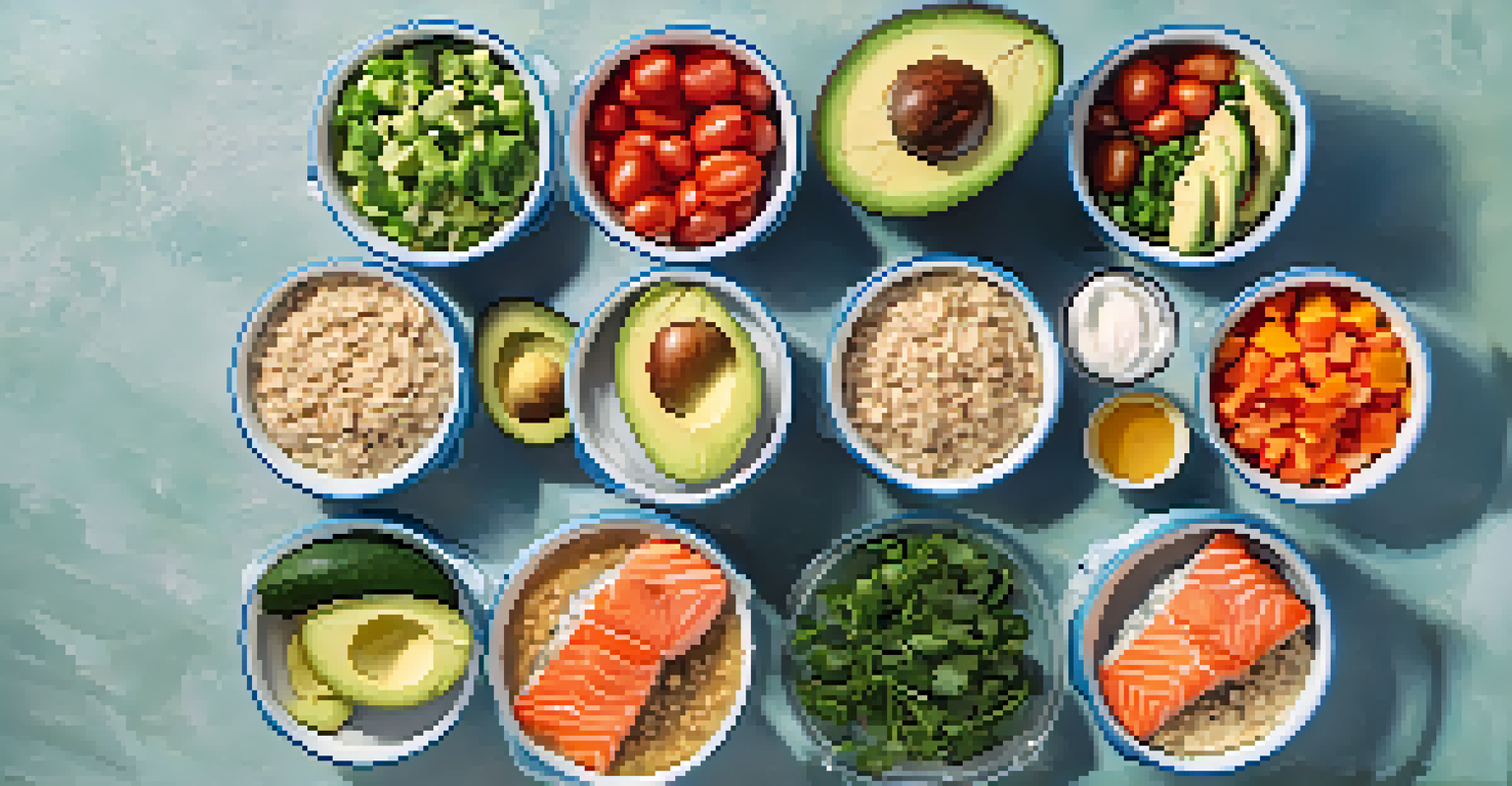Macronutrients: Fueling Dancers for Optimal Performance

Understanding Macronutrients: The Building Blocks of Nutrition
Macronutrients are the nutrients our bodies need in large amounts to function properly. They consist of carbohydrates, proteins, and fats, each playing a unique role in energy production and overall health. For dancers, understanding these components is crucial, as they provide the fuel needed for intense physical activity.
Let food be thy medicine and medicine be thy food.
Carbohydrates are often considered the body's primary energy source. When dancers consume carbs, they are essentially stocking up on glucose, which can be quickly converted into energy during a performance or rehearsal. This is why a dancer's diet should include a variety of carbohydrate-rich foods, such as fruits, vegetables, and whole grains.
Proteins, on the other hand, are essential for muscle repair and recovery. After a long dance session, muscles need protein to heal and grow stronger. This nutrient is vital for dancers, as it helps them maintain their strength and stamina, ensuring they can perform at their best.
The Role of Carbohydrates in Dance Performance
Carbohydrates are the star players in a dancer's diet, providing the energy needed to power through rehearsals and performances. Think of carbs as the fuel for a race car; without them, the engine won't run smoothly. Dancers should focus on consuming complex carbohydrates, like whole grains, to ensure a steady release of energy throughout their activities.

Including carbohydrates in pre-performance meals can enhance stamina and mental clarity. Foods like oatmeal, brown rice, and bananas are excellent choices that help maintain energy levels. Additionally, it's important for dancers to time their carbohydrate intake effectively, consuming a good meal a few hours before dancing for optimal results.
Macronutrients Fuel Performance
Carbohydrates, proteins, and fats are essential for dancers, providing the energy, recovery, and nutrient absorption needed to excel in their performances.
However, the quantity and quality of carbohydrates matter. Dancers should be mindful of portion sizes and strive for a balance that suits their individual energy needs. By prioritizing nutrient-dense carbs, dancers can avoid the dreaded energy crash that may come from sugary snacks or refined grains.
Importance of Protein for Muscle Recovery in Dancers
Protein plays a critical role in muscle recovery, especially for dancers who put their bodies through strenuous routines. After an intense rehearsal, protein-rich foods help repair muscle fibers that may have been damaged, allowing dancers to bounce back stronger. Incorporating lean proteins like chicken, fish, and legumes into meals can help meet these needs.
You are what you eat, so don’t be fast, cheap, easy, or fake.
Moreover, adequate protein intake can improve overall performance by promoting muscle growth and enhancing strength. This means dancers can execute more powerful movements and maintain better control over their bodies. Aiming for a balanced intake throughout the day can be beneficial, especially after workouts when muscles are most receptive to nutrients.
It's also worth noting that protein needs can vary based on the intensity of dancing and individual body composition. Dancers should consider consulting with a nutritionist to create a tailored plan that meets their specific protein requirements, ensuring optimal recovery and performance.
Fats: The Essential Macronutrient for Dancers
Fats are often misunderstood but are vital for dancers, providing a concentrated source of energy. While carbs are the go-to for immediate energy, fats offer longer-lasting fuel, helping dancers maintain endurance during lengthy performances. Healthy fats, such as avocados, nuts, and olive oil, should be included in a dancer's diet for optimal energy levels.
In addition to energy, fats play a key role in hormone production and nutrient absorption. This is particularly important for dancers, as hormones can affect mood, energy levels, and, ultimately, performance. A balanced diet that includes healthy fats can contribute to overall well-being and help dancers feel their best both on and off the stage.
Hydration is Key for Dancers
Staying hydrated is crucial for maintaining energy levels and preventing fatigue during dance sessions, making water an often-overlooked essential nutrient.
It's essential for dancers to choose the right types of fats. Unsaturated fats are healthier options that can promote heart health and reduce inflammation. By incorporating a variety of fats into their meals, dancers can support their bodies and maintain peak performance.
Hydration: The Overlooked Macronutrient for Dancers
While not a macronutrient in the traditional sense, hydration is critical for dancers and should not be overlooked. Water plays a vital role in every bodily function, including digestion, temperature regulation, and muscle contraction. Staying hydrated helps dancers maintain their energy levels and reduces the risk of cramps or fatigue during performances.
Dancers should aim to drink water consistently throughout the day, not just during practice. A good rule of thumb is to sip water before, during, and after dance sessions. Adding electrolyte-rich drinks can also be beneficial, especially after intense workouts, to replenish lost minerals and maintain hydration balance.
It's important for dancers to listen to their bodies when it comes to hydration. Signs of dehydration can include dizziness, fatigue, and decreased performance. By prioritizing hydration, dancers can support their physical performance and enhance their overall well-being.
Meal Timing: Strategizing Nutrition for Performance
Meal timing is a crucial aspect of a dancer's nutrition strategy. Consuming the right foods at the right times can significantly impact energy levels and performance. Dancers should focus on eating a balanced meal containing carbohydrates, proteins, and fats about two to three hours before dancing to fuel their bodies effectively.
Additionally, snacks can play a vital role in maintaining energy levels throughout the day. Quick, nutritious snacks like yogurt, fruit, or energy bars can provide a boost of energy when needed. Timing these snacks strategically before or after rehearsals can help ensure dancers have the stamina to perform at their best.
Meal Timing Boosts Energy Levels
Strategically timing meals and snacks can significantly enhance a dancer's energy and recovery, optimizing overall performance.
Lastly, post-dance meals are just as important as pre-dance nutrition. Eating a combination of protein and carbohydrates after practice can aid recovery and prepare the body for the next session. By understanding and implementing meal timing strategies, dancers can optimize their performance and recovery.
Creating a Balanced Plate: Practical Tips for Dancers
Creating a balanced plate is essential for dancers to ensure they are getting the right mix of macronutrients. A simple way to do this is by following the 'plate method.' Imagine dividing your plate into sections: half should be filled with vegetables and fruits, one-quarter with protein, and the remaining quarter with whole grains. This visual guide helps maintain balance without the need for precise measurements.
Incorporating a variety of colors on the plate can also enhance the nutritional quality of meals. Different colored fruits and vegetables provide a range of vitamins and minerals that support overall health and performance. Dancers should experiment with seasonal produce to keep their meals exciting and flavorful.

Finally, meal prepping can be a game-changer for busy dancers. Preparing meals in advance ensures a nutritious option is always available, reducing the temptation to grab less healthy choices on the go. By focusing on creating balanced meals, dancers can fuel their bodies for optimal performance.